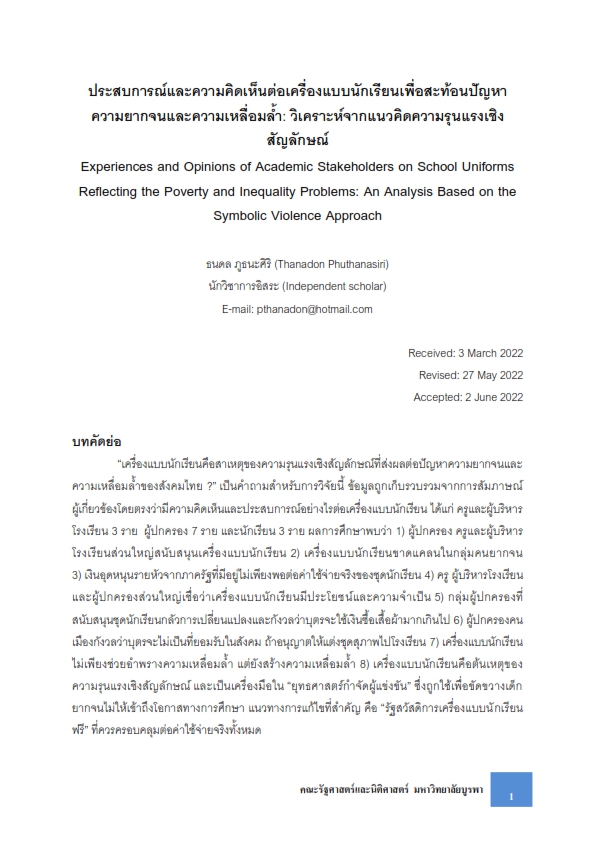Experiences and Opinions of Academic Stakeholders on School Uniforms Reflecting the Poverty and Inequality Problems: An Analysis Based on the Symbolic Violence Approach
Keywords:
Experiences and opinions, School uniform , Poverty and inequality, Symbolic violenceAbstract
Are school uniforms being the cause of symbolic violence that affects poverty and inequality in Thailand? is the question that this research determines to answer. The data was collected through interviews with relevant stakeholders including 3 teachers and school administrators, 7 parents, and 3 students to obtain their experiences and opinions towards the school uniforms. The study found that 1) The majority of parents, teachers, and school administrators support school uniforms. 2) School uniforms are inadequate among the poor. 3) The existing Government welfare scheme is insufficient to cover the actual expenses of school uniforms. 4) Most teachers, school administrators, and parents believe that school uniforms are useful and necessary. 5) Parents who support school uniforms are afraid of change and are concerned that their children would spend money excessively on clothes. 6) Urban parents are concerned that their children would not be socially accepted if school uniforms were not mandatory. 7) The school uniforms are not only hiding inequality but also create inequality. 8) The school uniforms are the cause of symbolic violence, and a tool in the “Strategy for eliminating competitors”, which is used to prevent poor children from accessing educational opportunities. The solution is to have a “free school uniform welfare provided by the state” to cover all costs of school uniforms.
References
รายการอ้างอิง
ภาษาไทย
กองทุนเพื่อความเสมอภาคทางการศึกษา. (2563). ส่องตัวเลขจาก Big Data ที่เผยความเหลื่อมล้ำทาง การศึกษาที่คุณอาจไม่เคยเห็น. กองทุนเพื่อความเสมอภาคทางการศึกษา. วันที่ค้นข้อมูล 6 สิงหาคม 2565, เข้าถึงได้จาก https://www.eef.or.th/infographic-06-08-10/
ไทยพับลิก้า. (2565). ถอดแก่นคิดโรงเรียนสาธิตธรรมศาสตร์ ปั้นเด็กปั้นอนาคตไทย (1). วันที่ค้นข้อมูล 17 กุมภาพันธ์ 2565, เข้าถึงได้จาก https://thaipublica.org/2022/02/thammasat-secondary- school01/
ธนดล ภูธนะศิริ. (2556). การพัฒนาทุนในตัวมนุษย์สู่ความเป็นชนชั้นนำในสถาบันอุดมศึกษาของไทย และสถาบันอุดมศึกษาของฝรั่งเศส: วิเคราะห์ตามแนวคิดทุนของบูร์ดิเออ. ดุษฎีนิพนธ์ปริญญา ศึกษาศาสตรดุษฎีบัณฑิต, มหาวิทยาลัยเซนต์จอห์น.
ธนดล ภูธนะศิริ. (2564). ชุดนักเรียน: เครื่องมืออำพรางความเหลื่อมล้ำของสังคมไทย. วารสารรัฐศาสตร์ สารมหาวิทยาลัยธรรมศาสตร์, 42(3), 1-24.
เนชั่นออนไลน์. (2560). โรงเรียนนี้ไม่มียูนิฟอร์ม สาธิตฯ มธ. วันที่ค้นข้อมูล 6 กันยายน 2564, เข้าถึงได้ จาก https://www.nationtv.tv/news/378567231
ปราย พันแสง. (2564). ค่าเทอมน้องพิมพ์กาญจน์. วันที่ค้นข้อมูล 30 สิงหาคม 2564, เข้าถึงได้จาก https://www.facebook.com/prypansang/posts/395555585262843
มติชนสุดสัปดาห์. (2564, 31 มีนาคม). ครูญี่ปุ่นล่ารายชื่อส่ง กระทรวงศึกษาฯ ยกเลิกบังคับชุดนร.
มุ่งแก้ปัญหาสังคม. วันที่ค้นข้อมูล 31 มีนาคม 2564, เข้าถึงได้จาก https://www.matichonweekly.com/hot-news/article_414233
มติชนออนไลน์. (2563ก). แม่ขโมยชุดนักเรียนในห้าง เอาให้ลูกใส่ไปโรงเรียนพรุ่งนี้. วันที่ค้นข้อมูล 30 มิถุนายน 2564, เข้าถึงได้จาก https://www.matichon.co.th/news-monitor/ news_2249540
มติชนออนไลน์. (2563ข). ผู้อ่านส่วนใหญ่คิดว่าชุดนักเรียนไม่จำเป็นแล้วสำหรับการศึกษาในตอนนี้.
วันที่ค้นข้อมูล 1 กรกฎาคม 2564, เข้าถึงได้จาก https://www.matichon.co.th/ matichon- poll/news_2250925
สถาบันบัณฑิตพัฒนบริหารศาสตร์. (2565). เครื่องแบบนักเรียน จะเอาอย่างไร?. วันที่ค้นข้อมูล 17 มกราคม 2564, เข้าถึงได้จาก https://nidapoll.nida.ac.th/survey_detail?survey_id=459
สุภางค์ จันทวานิช. (2551). วิธีการวิจัยเชิงคุณภาพ. กรุงเทพฯ: จุฬาลงกรณ์มหาวิทยาลัย.
สำนักนโยบายและยุทธศาสตร์ สำนักงานปลัดกระทรวงศึกษาธิการ. (2552). การดำเนินงานนโยบายเรียน
ฟรี 15 ปี อย่างมีคุณภาพ. กรุงเทพฯ: กระทรวงศึกษาธิการ.
ภาษาอังกฤษ
Cinoglu, M. (2014). Evaluation of school uniform policy in Turkey: A case study. International journal of progressive education, 10(3), 97-108.
Haggard, S. (2016). Reflections on inequality in Asia. Global Asia, 11(2), 8-13.
Imangie Burundi-Terimbere Foundation. (2022). School uniform & little sun solar lamp.
Imangie Burundi-Terimbere Foundation. Retrieved March 20, 2021, from http://imagine-burundi-terimbere.com/contact/school-uniform-and-little-sun.html
ProCon.org. (2021, May 3). History of School Uniforms. Retrieved March 20, 2021, from https://school-uniforms.procon.org/history-of-school-uniforms
Reidy, J. (2021). Reviewing school uniform through a public health lens: Evidence about the
impacts of school uniform on education and health. Public Health Reviews, 42, 1-17.
Robbins, S. P., & Coulter, M. (2018). Management (14th ed.). London: Pearson.
Sabic-El-Rayess, A., Mansur, N. N., Batkhuyag, B., & Otgonlkhagva, S. (2019). School uniform
policy’s adverse impact on equity and access to schooling. Compare: A journal of comparative and international education, 50(8), 1-18.
Vopat, M. C. (2010). Mandatory school uniforms and freedom of expression. Ethics and
Education, 5(3), 203-215.
Wilkinson, R., & Pickett, K. (2010). The spirit level: Why equality is better for everyone.
London: Penguin Books.
ภาษาฝรั่งเศส
Bourdieu, P., & Passeron, J. C. (1970). La Reproduction.Éléments pour une théorie du
système d’enseignement. Paris, France: Minuit.
Bourdieu, P. (1989). La Noblesse d’État. Grandes écoles et esprit de corps. Paris, France: Minuit.
Bourdieu, P. (1993). La Misère du monde. Paris, France: Seuil.
Bourdieu, P. (1994). Raisons pratiques. Sur la théorie de l’action. Paris, France: Seuil.
Dortier, J. F. (2009). Max Weber, Sociologue de la modernité. dans Molénat, X. (Éd),
La Sociologie. Histoire, idées, courants. Auxerre, France: Sciences Humaines Éditions.
Encyclopædia Universalis. (2021). Violence symbolique. Retrieved March 20, 2021, from https://www.universalis.fr/encyclopedie/violence-symbolique/






